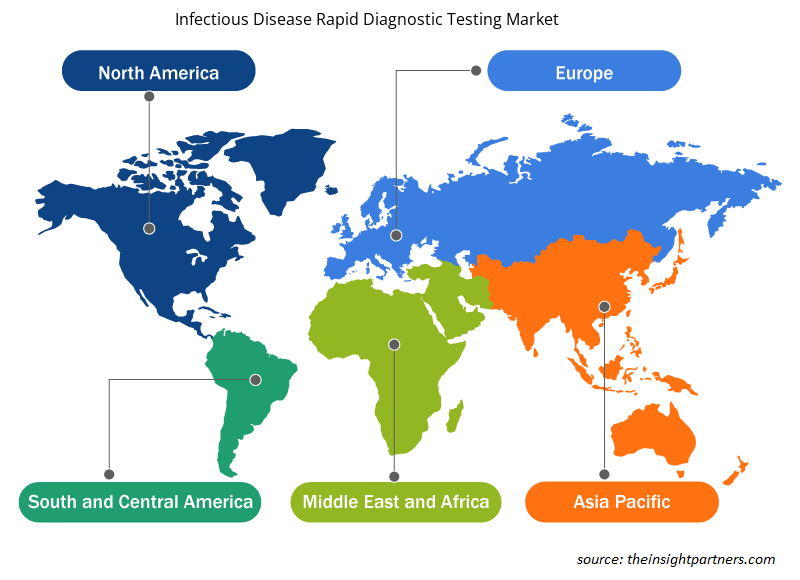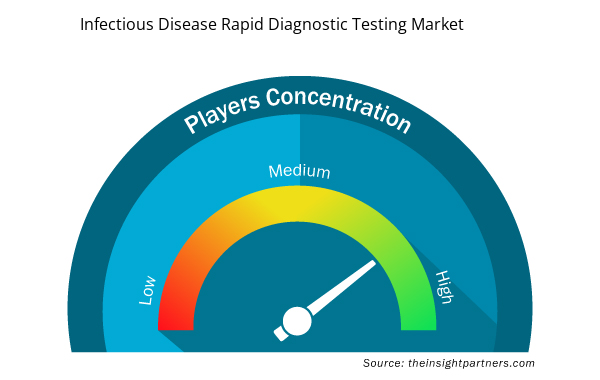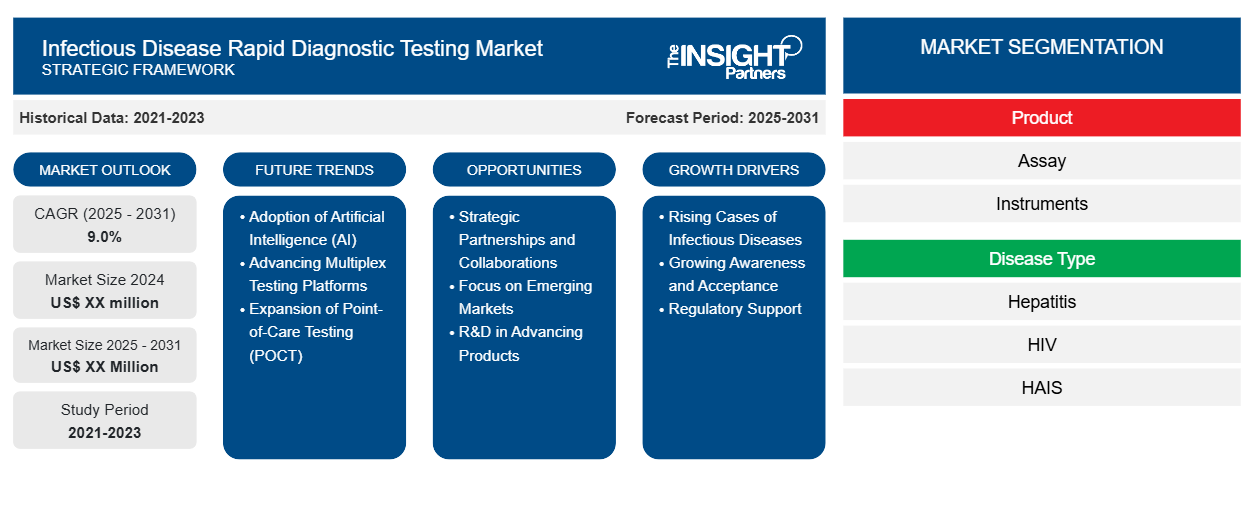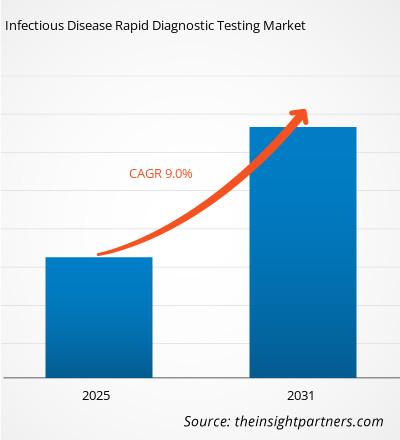Le marché des tests de diagnostic rapide des maladies infectieuses devrait enregistrer un TCAC de 9,0 % de 2023 à 2031, avec une taille de marché passant de XX millions USD en 2023 à XX millions USD d'ici 2031.
Le rapport présente une analyse basée sur le produit (test, instruments) et par type de maladie (hépatite, VIH, HAIS , HPV, tuberculose, grippe, autres maladies). Le rapport fournit une analyse basée sur la technologie ( immunodiagnostic , microbiologie clinique, PCR , INAAT , autres). Le rapport fournit en outre une analyse basée sur l'utilisateur (hôpitaux, cliniques, laboratoires de diagnostic, autres). L'analyse mondiale est ensuite décomposée au niveau régional et par principaux pays. La taille du marché et les prévisions aux niveaux mondial, régional et national pour tous les segments de marché clés sont couvertes dans le cadre du périmètre. Le rapport offre la valeur en USD pour l'analyse et les segments ci-dessus. Le rapport fournit des statistiques clés sur l'état du marché des principaux acteurs du marché et offre des tendances et des opportunités de marché.
Objectif du rapport
Le rapport sur le marché des tests de diagnostic rapide des maladies infectieuses de The Insight Partners vise à décrire le paysage actuel et la croissance future, les principaux facteurs moteurs, les défis et les opportunités. Cela fournira des informations à diverses parties prenantes commerciales, telles que :
- Fournisseurs/fabricants de technologie : pour comprendre l’évolution de la dynamique du marché et connaître les opportunités de croissance potentielles, leur permettant de prendre des décisions stratégiques éclairées.
- Investisseurs : Effectuer une analyse complète des tendances concernant le taux de croissance du marché, les projections financières du marché et les opportunités qui existent tout au long de la chaîne de valeur.
- Organismes de réglementation : Réglementer les politiques et surveiller les activités du marché dans le but de minimiser les abus, de préserver la confiance des investisseurs et de maintenir l’intégrité et la stabilité du marché.
Segmentation du marché des tests de diagnostic rapide des maladies infectieuses
Produit
- Essai
- Instruments
Type de maladie
- Hépatite
- VIH
- HAIS
- VPH
- tuberculose
- Grippe
- Autres maladies
Technologie
- Immunodiagnostic
- Microbiologie clinique
- PCR
- INAAT
- Autres
Utilisateur final
- Hôpitaux
- Cliniques
- Laboratoires de diagnostic
- Autres
Utilisateur final
- Hôpitaux
- Cliniques
- Laboratoires de diagnostic
- Autres
Personnalisez ce rapport en fonction de vos besoins
Vous bénéficierez d'une personnalisation gratuite de n'importe quel rapport, y compris de certaines parties de ce rapport, d'une analyse au niveau des pays, d'un pack de données Excel, ainsi que de superbes offres et réductions pour les start-ups et les universités.
- Obtenez les principales tendances clés du marché de ce rapport.Cet échantillon GRATUIT comprendra une analyse de données, allant des tendances du marché aux estimations et prévisions.
Facteurs de croissance du marché des tests de diagnostic rapide des maladies infectieuses
- Augmentation des cas de maladies infectieuses : les gouvernements et les groupes de santé font du diagnostic rapide une priorité absolue pour améliorer la surveillance et la réponse aux maladies. À mesure que les maladies infectieuses deviennent plus courantes, le besoin de solutions de test rapides ne cesse de croître. Cela crée des opportunités rentables pour les entreprises du marché.
- Sensibilisation et acceptation croissantes : les campagnes de santé publique et les initiatives éducatives ont sensibilisé la population aux symptômes et à la transmission et les gens adoptent une approche proactive en matière de dépistage. L'acceptation des tests rapides, en particulier lors d'épidémies comme celle de la COVID-19, a prouvé leur valeur dans la gestion des crises de santé publique. Les professionnels de la santé et les patients reconnaissent la commodité et la rapidité des tests rapides et leur adoption augmente donc.
- Soutien réglementaire : Le financement des gouvernements et des organismes de santé est un facteur clé du marché des tests de diagnostic rapide des maladies infectieuses. Les autorités simplifient le processus d'approbation des nouvelles technologies de diagnostic afin qu'elles puissent atteindre le marché plus rapidement. Des initiatives telles que le Global Health Security Agenda (GHSA) visent à améliorer les capacités de diagnostic à l'échelle mondiale et à créer un environnement propice à l'innovation. Cet environnement réglementaire favorable et ces financements permettent aux entreprises de développer et de commercialiser des solutions de diagnostic avancées et de stimuler la croissance du marché.
Tendances futures du marché des tests de diagnostic rapide des maladies infectieuses
- Adoption de l'intelligence artificielle (IA) : la capacité de l'IA à générer et exploiter des données massives permet d'améliorer la précision du diagnostic, car ces méthodes peuvent analyser les informations et découvrir des irrégularités que les méthodes traditionnelles n'auraient pas pu déceler. De telles analyses prédictives par le biais d'algorithmes d'apprentissage automatique peuvent aider à prévoir l'incidence des maladies et les résultats des patients, permettant ainsi des interventions rapides de la part des prestataires de soins de santé.
- Développement des plateformes de tests multiplex : Le développement des tests multiplex permet de détecter plusieurs agents pathogènes à partir d'un seul échantillon, ce qui est important dans la gestion des co-infections. Les stratégies cliniques basées sur le diagnostic rapide de plusieurs agents infectieux améliorent la pratique clinique, en particulier dans le cas des soins médicaux d'urgence. Alors que les problèmes de santé à l'échelle mondiale se compliquent, des tests de diagnostic polyvalents, tels que les tests multiplex, seront indispensables, ce qui contribuera à son tour au développement et à l'utilisation de ces services.
- Expansion des tests au point de service (POCT) : L’autre tendance importante sur le marché des tests de diagnostic rapide des infections est l’expansion des POCT. Il permet d’effectuer des tests de diagnostic sur place ou à proximité immédiate du patient, offrant ainsi aux patients la possibilité de recevoir un diagnostic et un traitement en temps opportun, sans délai. Une telle transformation est particulièrement pertinente pour les zones géographiques éloignées ou rurales où la présence d’un laboratoire est peu pratique.
Opportunités de marché pour les tests de diagnostic rapide des maladies infectieuses
- Partenariats et collaborations stratégiques : les partenariats stratégiques avec des prestataires de services de santé, des instituts de recherche et des entreprises technologiques sont susceptibles d’ouvrir la voie à de nouvelles opportunités de croissance. Travailler avec des acteurs stratégiques du système de santé permet aux entreprises d’améliorer leur part de marché, d’accélérer les cycles de développement des produits en cours de développement et d’accroître leur capacité à atteindre davantage de clients, ce qui se traduit par une augmentation du chiffre d’affaires.
- Focus sur les marchés émergents : Les pays en développement offrent un potentiel immense de croissance de la part de marché dans le secteur des tests de diagnostic rapide des maladies infectieuses. Avec le développement des infrastructures de santé dans des régions comme l'Asie-Pacifique et l'Amérique latine, on s'attend à une augmentation de la demande pour de telles solutions diagnostiques et thérapeutiques holistiques. En entrant et en s'implantant solidement sur ces marchés en développement, les acteurs peuvent viser à attirer de nouveaux groupes de clients, ce qui se traduira par une augmentation des revenus sur une période prolongée.
- R&D pour faire progresser les produits : L’intérêt d’investir en particulier dans la recherche et le développement (R&D) est qu’il permet aux acteurs du marché d’être créatifs et d’éviter toute concurrence. Les entreprises peuvent se concentrer sur le développement de tests de diagnostic rapides avancés sur site qui intègrent des technologies telles que CRISPR, la nanotechnologie ou les biocapteurs, qui sont plus faciles à fabriquer et moins chers à déployer, et plus précis et plus rapides.
Aperçu régional du marché des tests de diagnostic rapide des maladies infectieuses
Les tendances régionales et les facteurs influençant le marché des tests de diagnostic rapide des maladies infectieuses tout au long de la période de prévision ont été expliqués en détail par les analystes d’Insight Partners. Cette section traite également des segments et de la géographie du marché des tests de diagnostic rapide des maladies infectieuses en Amérique du Nord, en Europe, en Asie-Pacifique, au Moyen-Orient et en Afrique, ainsi qu’en Amérique du Sud et en Amérique centrale.

- Obtenez les données régionales spécifiques au marché des tests de diagnostic rapide des maladies infectieuses
Portée du rapport sur le marché des tests de diagnostic rapide des maladies infectieuses
| Attribut de rapport | Détails |
|---|---|
| Taille du marché en 2023 | XX millions de dollars américains |
| Taille du marché d'ici 2031 | XX millions de dollars américains |
| Taux de croissance annuel composé mondial (2023-2031) | 9,0% |
| Données historiques | 2021-2022 |
| Période de prévision | 2024-2031 |
| Segments couverts | Par produit
|
| Régions et pays couverts | Amérique du Nord
|
| Leaders du marché et profils d'entreprises clés |
|
Densité des acteurs du marché des tests de diagnostic rapide des maladies infectieuses : comprendre son impact sur la dynamique commerciale
Le marché des tests de diagnostic rapide des maladies infectieuses connaît une croissance rapide, tirée par la demande croissante des utilisateurs finaux en raison de facteurs tels que l'évolution des préférences des consommateurs, les avancées technologiques et une plus grande sensibilisation aux avantages du produit. À mesure que la demande augmente, les entreprises élargissent leurs offres, innovent pour répondre aux besoins des consommateurs et capitalisent sur les tendances émergentes, ce qui alimente davantage la croissance du marché.
La densité des acteurs du marché fait référence à la répartition des entreprises ou des sociétés opérant sur un marché ou un secteur particulier. Elle indique le nombre de concurrents (acteurs du marché) présents sur un marché donné par rapport à sa taille ou à sa valeur marchande totale.
Les principales entreprises opérant sur le marché des tests de diagnostic rapide des maladies infectieuses sont :
- Laboratoires Abbott
- Becton Dickinson et compagnie
- Biomérieux SA
- Société Danaher
- Laboratoires Bio-Rad
Avis de non-responsabilité : les sociétés répertoriées ci-dessus ne sont pas classées dans un ordre particulier.

- Obtenez un aperçu des principaux acteurs du marché des tests de diagnostic rapide des maladies infectieuses
Principaux arguments de vente
- Couverture complète : Le rapport couvre de manière exhaustive l’analyse des produits, des services, des types et des utilisateurs finaux du marché des tests de diagnostic rapide des maladies infectieuses, offrant un paysage holistique.
- Analyse d’experts : Le rapport est compilé sur la base d’une compréhension approfondie des experts et analystes du secteur.
- Informations à jour : Le rapport garantit la pertinence commerciale en raison de sa couverture des informations récentes et des tendances des données.
- Options de personnalisation : ce rapport peut être personnalisé pour répondre aux exigences spécifiques du client et s'adapter parfaitement aux stratégies commerciales.
Le rapport de recherche sur le marché des tests de diagnostic rapide des maladies infectieuses peut donc aider à ouvrir la voie au décodage et à la compréhension du scénario de l’industrie et des perspectives de croissance. Bien qu’il puisse y avoir quelques préoccupations valables, les avantages globaux de ce rapport ont tendance à l’emporter sur les inconvénients.
- Analyse historique (2 ans), année de base, prévision (7 ans) avec TCAC
- Analyse PEST et SWO
- Taille du marché Valeur / Volume - Mondial, Régional, Pays
- Industrie et paysage concurrentiel
- Ensemble de données Excel



Report Coverage
Revenue forecast, Company Analysis, Industry landscape, Growth factors, and Trends

Segment Covered
This text is related
to segments covered.

Regional Scope
North America, Europe, Asia Pacific, Middle East & Africa, South & Central America

Country Scope
This text is related
to country scope.
Questions fréquemment posées
Asia Pacific region is likely to witness the fastest growth rate during the forecast period.
North America dominated the infectious disease rapid diagnostic testing market in 2023
Advancing multiplex testing platforms is likely to remain the key trend during the forecast period.
C R Bard Inc Stryker Cook Degania Silicone Ltd Poly Medicure Limited Global Medikit Limited Romsons Cardinal Health B Braun Melsungen AG
The market drivers include the increasing surgical procedures, technological advancements, and rising awareness about infection control.
The infectious disease rapid diagnostic testing market is estimated to witness a CAGR of 9.0% from 2023 to 2031
Trends and growth analysis reports related to Life Sciences : READ MORE..
1. Abbott Laboratories
2. Becton Dickinson and Company
3. Biomérieux SA
4. Danaher Corporation
5. Bio-Rad Laboratories
6. Siemens AG
7. Diasorin
8. Luminex
9. Meridian Bioscience
10. Roche Diagnostics
The Insight Partners performs research in 4 major stages: Data Collection & Secondary Research, Primary Research, Data Analysis and Data Triangulation & Final Review.
- Data Collection and Secondary Research:
As a market research and consulting firm operating from a decade, we have published and advised several client across the globe. First step for any study will start with an assessment of currently available data and insights from existing reports. Further, historical and current market information is collected from Investor Presentations, Annual Reports, SEC Filings, etc., and other information related to company’s performance and market positioning are gathered from Paid Databases (Factiva, Hoovers, and Reuters) and various other publications available in public domain.
Several associations trade associates, technical forums, institutes, societies and organization are accessed to gain technical as well as market related insights through their publications such as research papers, blogs and press releases related to the studies are referred to get cues about the market. Further, white papers, journals, magazines, and other news articles published in last 3 years are scrutinized and analyzed to understand the current market trends.
- Primary Research:
The primarily interview analysis comprise of data obtained from industry participants interview and answers to survey questions gathered by in-house primary team.
For primary research, interviews are conducted with industry experts/CEOs/Marketing Managers/VPs/Subject Matter Experts from both demand and supply side to get a 360-degree view of the market. The primary team conducts several interviews based on the complexity of the markets to understand the various market trends and dynamics which makes research more credible and precise.
A typical research interview fulfils the following functions:
- Provides first-hand information on the market size, market trends, growth trends, competitive landscape, and outlook
- Validates and strengthens in-house secondary research findings
- Develops the analysis team’s expertise and market understanding
Primary research involves email interactions and telephone interviews for each market, category, segment, and sub-segment across geographies. The participants who typically take part in such a process include, but are not limited to:
- Industry participants: VPs, business development managers, market intelligence managers and national sales managers
- Outside experts: Valuation experts, research analysts and key opinion leaders specializing in the electronics and semiconductor industry.
Below is the breakup of our primary respondents by company, designation, and region:

Once we receive the confirmation from primary research sources or primary respondents, we finalize the base year market estimation and forecast the data as per the macroeconomic and microeconomic factors assessed during data collection.
- Data Analysis:
Once data is validated through both secondary as well as primary respondents, we finalize the market estimations by hypothesis formulation and factor analysis at regional and country level.
- Macro-Economic Factor Analysis:
We analyse macroeconomic indicators such the gross domestic product (GDP), increase in the demand for goods and services across industries, technological advancement, regional economic growth, governmental policies, the influence of COVID-19, PEST analysis, and other aspects. This analysis aids in setting benchmarks for various nations/regions and approximating market splits. Additionally, the general trend of the aforementioned components aid in determining the market's development possibilities.
- Country Level Data:
Various factors that are especially aligned to the country are taken into account to determine the market size for a certain area and country, including the presence of vendors, such as headquarters and offices, the country's GDP, demand patterns, and industry growth. To comprehend the market dynamics for the nation, a number of growth variables, inhibitors, application areas, and current market trends are researched. The aforementioned elements aid in determining the country's overall market's growth potential.
- Company Profile:
The “Table of Contents” is formulated by listing and analyzing more than 25 - 30 companies operating in the market ecosystem across geographies. However, we profile only 10 companies as a standard practice in our syndicate reports. These 10 companies comprise leading, emerging, and regional players. Nonetheless, our analysis is not restricted to the 10 listed companies, we also analyze other companies present in the market to develop a holistic view and understand the prevailing trends. The “Company Profiles” section in the report covers key facts, business description, products & services, financial information, SWOT analysis, and key developments. The financial information presented is extracted from the annual reports and official documents of the publicly listed companies. Upon collecting the information for the sections of respective companies, we verify them via various primary sources and then compile the data in respective company profiles. The company level information helps us in deriving the base number as well as in forecasting the market size.
- Developing Base Number:
Aggregation of sales statistics (2020-2022) and macro-economic factor, and other secondary and primary research insights are utilized to arrive at base number and related market shares for 2022. The data gaps are identified in this step and relevant market data is analyzed, collected from paid primary interviews or databases. On finalizing the base year market size, forecasts are developed on the basis of macro-economic, industry and market growth factors and company level analysis.
- Data Triangulation and Final Review:
The market findings and base year market size calculations are validated from supply as well as demand side. Demand side validations are based on macro-economic factor analysis and benchmarks for respective regions and countries. In case of supply side validations, revenues of major companies are estimated (in case not available) based on industry benchmark, approximate number of employees, product portfolio, and primary interviews revenues are gathered. Further revenue from target product/service segment is assessed to avoid overshooting of market statistics. In case of heavy deviations between supply and demand side values, all thes steps are repeated to achieve synchronization.
We follow an iterative model, wherein we share our research findings with Subject Matter Experts (SME’s) and Key Opinion Leaders (KOLs) until consensus view of the market is not formulated – this model negates any drastic deviation in the opinions of experts. Only validated and universally acceptable research findings are quoted in our reports.
We have important check points that we use to validate our research findings – which we call – data triangulation, where we validate the information, we generate from secondary sources with primary interviews and then we re-validate with our internal data bases and Subject matter experts. This comprehensive model enables us to deliver high quality, reliable data in shortest possible time.


 Obtenez un échantillon gratuit pour ce rapport
Obtenez un échantillon gratuit pour ce rapport